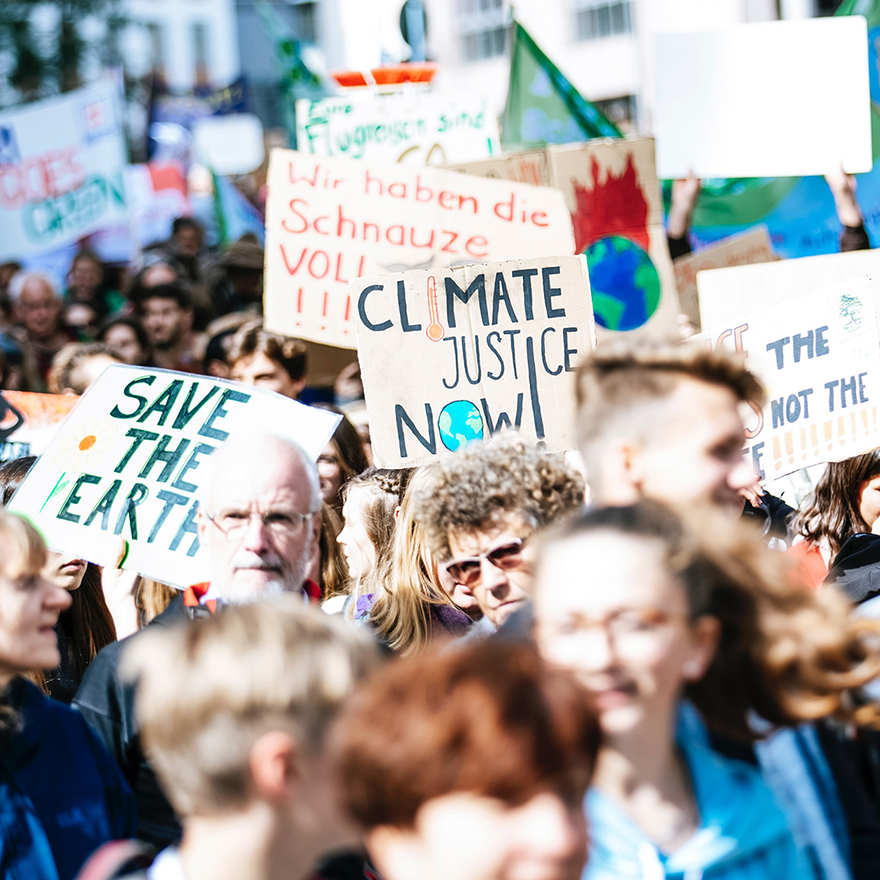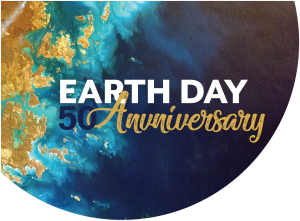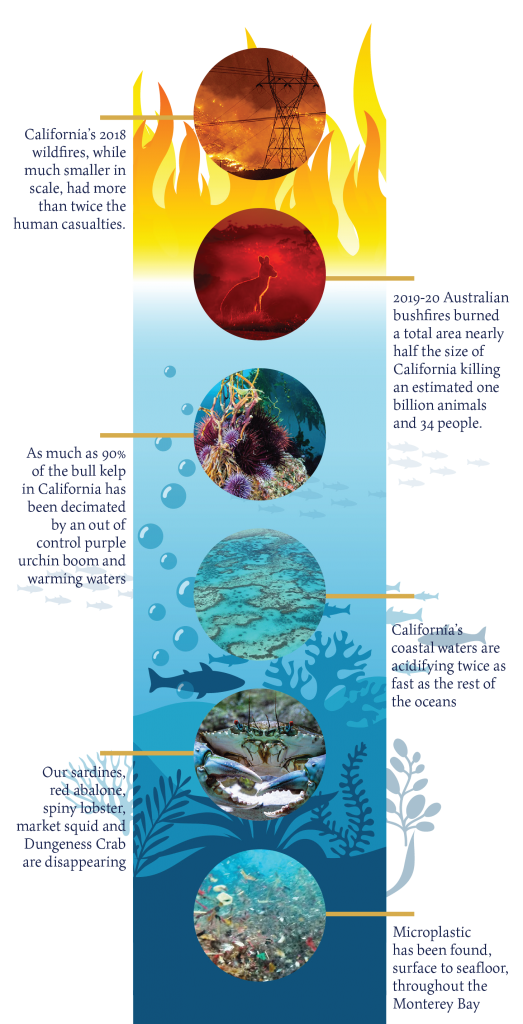
 On April 22, 1970, a year after a massive oil spill in Santa Barbara, 20 million Americans — 10% of the total population of the U.S. in 1970 — rallied coast-to-coast channeling the energy of the era’s anti-war protests to raise public awareness about the deterioration of our environment and corporate pollution of air and water.
On April 22, 1970, a year after a massive oil spill in Santa Barbara, 20 million Americans — 10% of the total population of the U.S. in 1970 — rallied coast-to-coast channeling the energy of the era’s anti-war protests to raise public awareness about the deterioration of our environment and corporate pollution of air and water.
We can thank those original Earth Day protesters for the creation of the U.S. Environmental Protection Agency (EPA) and the passage of the Clean Air, Clean Water and Endangered Species Acts. On April 22, 1990, 200 million people in 141 countries mobilized as Earth Day became a global protest in defense of our planet.
 Sadly, many of the environmental wins inspired by the original Earth Day have been rolled back, diluted, and dismantled by the current U.S. Administration. Our planet is once again in peril and our Golden State is on the front lines of the climate and environmental crisis.
Sadly, many of the environmental wins inspired by the original Earth Day have been rolled back, diluted, and dismantled by the current U.S. Administration. Our planet is once again in peril and our Golden State is on the front lines of the climate and environmental crisis.

On Earth Day 50th Anniversary, Santa Cruz Leads the World
By Tim Goncharoff, Zero Waste Programs Manager For Santa Cruz County & Gail McNulty, Sr Manager for Communications, Youth Leadership, & Climate Action for Save Our Shores
 In September 2019, Global Climate Strikes drew an estimated 6 million people worldwide, including impressive local turnouts in Santa Cruz and Watsonville, to focus attention on the United Nation’s warning that the window of opportunity to protect people and the planet from unmitigatable impacts of an escalating climate crisis is rapidly closing. Since September, global organizers including Youth for Climate Justice and the Sunrise Movement in Santa Cruz and Regeneración in Watsonville have been working to plan the biggest ever climate/environmental justice mobilization on the 50th Anniversary of Earth Day.
In September 2019, Global Climate Strikes drew an estimated 6 million people worldwide, including impressive local turnouts in Santa Cruz and Watsonville, to focus attention on the United Nation’s warning that the window of opportunity to protect people and the planet from unmitigatable impacts of an escalating climate crisis is rapidly closing. Since September, global organizers including Youth for Climate Justice and the Sunrise Movement in Santa Cruz and Regeneración in Watsonville have been working to plan the biggest ever climate/environmental justice mobilization on the 50th Anniversary of Earth Day.
Now, in response the the COVID-19 pandemic, organizers have pivoted and hope to flood the Internet with with #DigitalStrike(s) and #ClimateStrikeOnline creating a tremendous new opportunity for youth and families to get involved.
Children who grow up enjoying Santa Cruz’s redwoods, mountains, hiking and biking trails, and of course, our glorious Monterey Bay, are incredibly fortunate. This good fortune comes with responsibility.
From Junior Guards to Junior Rangers to Save Our Shores, O’Neill Sea Odyssey, and Watsonville Wetlands field trips—Santa Cruz County kids learn to love and care for these unreal surroundings. Nonetheless, many may be surprised to learn the extent to which Santa Cruz’s often groundbreaking environmental protections have improved things at state, national, and even global levels.
Our county’s reputation as an innovator in creative new environmental protection laws and programs keeps many eyes focused on the area. Our local environmental ordinances have been duplicated more than 100 times, across California and beyond. County ordinances have been adopted in San Diego, San Francisco, Seattle, Boulder, Colorado, Miami and New York City. The County has also had a profound impact on the corporate world, encouraging more sustainable practices in many giant companies. A few examples:
Santa Cruz County and local cities were among the first to ban styrofoam in food service (later expanded to a ban on retail sales). Most businesses adjusted quickly but large chains had more trouble. Coldstone Creamery, the ice cream store, was reluctant to do something different in just their one local store. After a lot of back and forth with local government representatives, Coldstone decided to give up styrofoam – in all 1,400 US stores.
Safe recycling of electronic waste is a big problem. Too much of it goes to Third World countries where it is melted down over open fires, polluting the air and water and sickening local people. A program called e-Stewards offers certification for electronic waste recyclers who can demonstrate that they use all proper health and safety measures and don’t ship their e-waste overseas.
Santa Cruz created the first ordinance of its kind requiring that all e-waste collected in the county go only to an e-Stewards certified recycler. This created a problem for the country’s largest electronics retailer, Best Buy, which has a store on 41st Ave. Best Buy hosts its own in-house recycling program for e-waste, but it wasn’t certified. Notified of the county’s new requirement, the company hemmed and hawed for a while, but then decided to get with the program – and certified 1,150 stores across the country. However, they let that lapse and the county is working to get them back in the program.
The local program allowing people to drop off leftover medicines and used needles at any local pharmacy was the first of its kind in the United States. Widely emulated, it inspired a new state law that will soon offer the program across California and is prompting similar new laws all across the US.
Santa Cruz County has taken numerous steps to reduce waste and litter, including the world’s first ban on plastic straws. As of 2017, everything used in food service businesses has to be washable, recyclable or compostable. As always, local businesses were quick to adjust, while some of the chains struggled. But the changes worked. After several months of experience, Starbucks sent out a press release announcing that based on a successful trial run in Santa Cruz County, they were rolling out more sustainable products to more than 28,000 stores around the world.
In addition to the devastating impacts plastic pollution is having on our marine ecosystems, a 2019 WWF study concluded that we may all be eating, drinking, and breathing about a credit card’s worth of plastic a week further vindicating the plastic measures Santa Cruz County has pioneered and highlighting the need for our county to continue pushing for bold reforms.
The County has enacted numerous measures to limit plastic waste. Last year it passed another first-in-the-world law banning the tiny bottles of lotion, shampoo, etc. from hotel and motel rooms, encouraging the businesses to switch to refillable containers. Hotels were enthusiastic, not just at being more sustainable, but because the measure saves them money. Marriott, Hyatt and Hilton have announced plans to expand the practice to more than 10,000 hotels around the world.
The County and local cities are far from done. In the next few months, new rules will kick in requiring, among other things, a charge for all disposable cups to encourage customers to bring their own, a requirement that all businesses provide recycling bins for their customers, and that all food-service businesses provide compost bins and sign-up for food waste collection. Meanwhile, Save Our Shores will soon launch a countywide petition supporting a ban on single-use plastic beverage bottles—another step in the effort to “lead the way as we protect our Bay.”
Never underestimate the impact of the “Banana Slug Effect” or our county’s passionate and determined youth leaders. From youth-led climate strikes and rallies in Santa Cruz and Watsonville to Pajaro Valley High School’s Decolonization Garden to the young leaders who successfully advocated for a Santa Cruz County School Board Resolution protecting their right to protest in defense of their future—it’s clear the legacy of environmental protection in Santa Cruz will be in good hands.
As shelter-in-place rules keep your family home in the coming weeks, we invite you to transform anxiety into action. Consider posting your family’s art, poems, videos, and other creative climate and ocean awareness communications with the hashtag #ClimateStrikeOnline to make the Earth 50 #DigitalStrike a powerful, world-changing movement and/or take on one or more of our Earth Day 50 Action List ideas.
Visit Save Our Shores for more information SaveOurShores.org

- Make & share Earth Day 50 Climate Strike signs! Submit photos of your signs to Save Our Shores’ online gallery here.
- Post your climate strike signs to social media sites with the hashtags: #ClimateStrikeOnline, #schoolstrike4climate, #fridaysforfuture, and/or #DigitalStrike
- Hang the real sign(s) in your window or yard!
- Write a letter our federal officials to tell them to prioritize people, animals, and our planet over profit. Visit usa.gov/elected-officials for contact information
- Make a video, write a poem, or create art to show your love to our ocean and planet and the need to protect what we love. Post to social media with the hashtags: #ClimateStrikeOnline, #schoolstrike4climate, #fridaysforfuture, and/or #DigitalStrike AND tag @SaveOurShores!
- Learn more about how environmental activism has changed our world, ongoing challenges, and where we go from here. Visit EarthDay.org/history to read about The History of Earth Day.
- Take a hike or walk with a bucket and clean up trash as you go.
- Share your Earth Day Action Activities on Social Media and tag @GrowingUpSC




You May Also Like

Teaching from a Distance
April 1, 2020
These Judges Judge Your Kids
March 28, 2020

